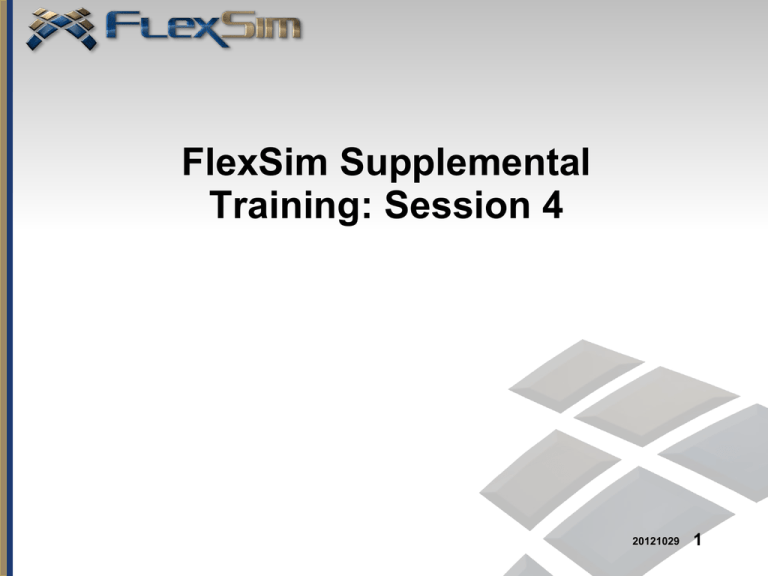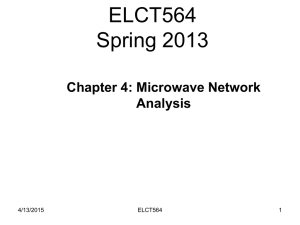Online Session 4x
advertisement

FlexSim Supplemental
Training: Session 4
20121029
1
Session Philosophy
• Increase your modelling power through:
– Knowing where and how model data is
stored/accessed
– Reusability
– Abstraction
– Be able to ask yourself: What Event and what
Object will allow me to accomplish what I
want?
2
The Flexsim Tree and
Flexscript
1.
2.
3.
4.
Trees and Nodes
Functions
Understanding Modeling events
The Modelling Language –
Flexscript
5. Model building
3
What is a Node?
• Basic data structure of Flexsim is a hierarchal tree
– main tree (model and project related objects and data)
– view tree (GUI related objects and picklists)
– model tree (model related objects and data)
• The node is the basic building block of a tree
• Nodes hold all the information behind the scenes
for objects, GUIs and data.
4
Node Structure
• Nodes have a name
• Nodes can have a data item
– number
– string
– object
• If nodes have object data, use > to view a
separate node list containing the object info
(data members and member functions)
• If nodes contain sub nodes, use + to expand
and view the child nodes
5
Node Symbols
Standard Folder
Object
Object data
Function (C++)
Function (FlexScript)
6
Sample Model Tree
7
What is a function?
functionname(argument1, argument2, etc)
• An argument can be:
– Numerical value
– String (“text“)
– Reference to an object or node
• Function example:
colorrandom(item)
– (see OnExit trigger of a Source object)
• Many of Flexsim’s functions are used to read data
from the tree and save data to the tree.
8
Functions and the ‘return’ statement
• Function ‘calls’ are like asking a question
• Input is required of the user and an
answer is given as a ‘return’ value
• Picklist properties on Objects are
functions
• The return values will mean different
things for each object function, it answers
the question asked by the function
9
Object Properties
• Understanding the edit fields of an object will
help you understand Flexsim.
• You should be able to answer the following
four questions about each edit field:
–
–
–
–
what is its purpose?
when is it evaluated?
what are its access variables?
what does it return?
10
Order of Execution
(pushed flowitem)
flowitem enters
OnEntry
Pick Operator
Process Time
delay
OnProcessFinish
OnExit
delay
Setup Time
Pick Operator
OnSetupFinish
Request
Transport From
delay
Send To Port
possible
delay
11
Access Variables & Returns
Edit Field
Access Variables
Returns
Setup Time
current, item, port
delay time
Process Time
current, item
delay time
Send To Port
current, item
port number
Pull From Port
current
port number
Pull Requirement
current, item, port
true/false (1/0)
Request Transport From
current, item, port
numeric pointer
Pick Operator
current, item
numeric pointer
OnReset
current
N/A
OnMessage
current, msgsendingobject,
msgparam1, msgparam2, msgparam3
N/A
OnEntry
current, item, port
N/A
OnExit
current, item, port
N/A
OnSetupFinish
current, item
N/A
OnProcessFinish
current, item
N/A
12
General Rules
• language is case sensitive (A does not equal a)
• no specific format is required (free use of spaces, tabs and line
returns are encouraged for readable code)
• text strings are entered between quotes. “mytext”
• parenthesis follow a function call and commas separate the
arguments of the function. moveobject(object1, object2);
• a function or command will always end with a SEMI-COLON (;)
• parenthesis can also be used freely to make associations in
your math and logic statements. Ex: ((x+3)*2)
• curly braces { } are used to define a block of statements.
• to comment the rest of a line use // and type note here
• multi-line comments start with /* and end with */.
• don’t use spaces or special characters in name definitions
( _ is ok).
• names may include numbers, but may not begin with a number
(machine_9 is acceptable, 9machine is not).
13
Variable Types
•
•
•
•
int
double
string
treenode
integer (1, 2, 3, 14324)
double precision (2.5, 3.14159)
text string (“Anthony was here.”)
reference to a node in the tree
14
Declaring and Setting Variables
•
•
•
•
int index = 1;
double weight = 175.8;
string category = “groceries”;
treenode forklift = centerobject(current,1);
15
Math Operators
•
•
•
•
•
•
•
•
•
•
•
x+y
x-y
x*y
x/y
sqrt(x)
pow(x,y)
round(x)
frac(x)
fmod(x,y)
min(x,y)
max(x,y)
x plus y
x minus y
x times y
x divided by y
square root of x
x to the power of y (xy)
x rounded to the nearest integer
returns the decimal portion of x
returns the remainder of x/y
returns minimum of x and y
returns maximum of x and y
16
Comparing
•
•
•
•
•
•
•
x>y
x<y
x >= y
x <= y
x == y
x != y
comparetext(string1,string2)
•
These values return TRUE or FALSE.
x greater than y
x less than y
x greater than or equal to y
x less than or equal to y
x equal to y
x not equal to y
string1 matches string2
17
Updating
•
•
•
•
•
•
•
x=y
x += y
x -= y
x *= y
x /= y
x ++
x --
set x to y
set x to x plus y
set x to x minus y
set x to x times y
set x to x divided by y
add 1 to x
subtract 1 from x
• Remember: ‘=‘ is not the same as ‘==‘
= is used to set a value
== is a comparison operator
18
Relating
• &&
• ||
• !
logical AND
logical OR
logical NOT
19
Logical ‘if’ Statement
if (test expression)
{
code block
}
else
{
code block
}
if (content(item) == 2)
{
colorred(item);
}
else
{
colorblack(item);
}
20
Logical ‘switch’ Statement
int type = getitemtype(item);
switch ( switchvariable )
{
case casenum:
{
code block
break;
}
case casenum2:
{
code block
break;
}
default:
{
code block
break;
}
}
switch (type)
{
case 1:
{
coloryellow(item);
break;
}
case 5:
{
colorred(item);
break;
}
default:
{
colorgreen(item);
break;
}
}
21
Basic Object Referencing
• current • item • model -
the current object, the owner of the code
the involved flowitem that triggered the event
references the model tree
• rank(node, ranknum)
• first(object)
• last(object)
rank(current,3)
first(current)
last(current)
• inobject(object, portnum)
• outobject(object, portnum)
• centerobject(object, portnum)
inobject(current,1)
outobject(current,1)
centerobject(current,1)
• node(“relativepath”, object)
node(“/Operator1”,model())
22
Basic Object Statistics
•
•
•
•
content( object )
getinput( object )
getoutput( object )
getstatenum( object ), setstatenum( object, value )
• int inventory = content(current);
• int produced = getoutput(current);
23
Accessing Data in the Tree
• getvarnum(object, “varname”), setvarnum(object, “varname”, value)
• getvarstr(object, “varname”), setvarstr(object, “varname”, string)
• getvarnode(object, “varname”)
• getnodenum(node), setnodenum(node, value)
• getnodestr(node), setnodestr (node, string)
• labels(object)
• itemtype(object)
Many nodes are arranged as tables within objects and can also be
accessed with the table commands
• gettablenum(ReferenceToTable, row, col), settablenum() etc.
24
Logical ‘while’ Statement
while (test expression)
{
code block
}
while (content(current) > 0)
{
destroyobject(last(current));
}
In programming, a while loop is a control structure that
allows a code block to be repeated as long as a test
expression is true. May also use the break or return
statement to force loop execution to halt.
Avoid infinite loops by ensuring that the test
expression will eventually fail.
25
Logical ‘for’ Statement
for (start expression; test expression; count expression)
{
//code block
}
for (int index=1; index<=content(current); index++)
{
colorblue(rank(current,index));
}
A for loop allows you to repeat a block of code a set
number of times. The head of the for loop defines the
repeat conditions:
1. specify a changing variable & give it an initial value
2. set a condition to exit the loop
3. how to treat your variable at the end of each iteration
Avoid infinite loops by ensuring that the test expression will
eventually fail.
26
Model Key Concepts
• Logic Control via Loops and Conditional
statements
• Locating, and manipulating data from
the Tree, ex. how does the Combiner
know how many flowitems to pack?
– Combiner component list table shows target quantities from each input port
– Additional node in its tree called targetcomponentsum which is the sum of
all target quantities from all input ports. The cumulative number of
flowitems to pack across all ports.
– If you need to alter the combiner’s component list dynamically, you need to
adjust both values; the value from each port, and the sum of all ports
27
Model Description
•
Purpose
– Practice using FlexScript to accomplish various modeling needs, such as
routing, decision making and object manipulation.
•
Description
– 4 item types, distributed according to the duniform distribution, enter a
conveyor, and are routed to 1 of 2 object groups consisting of a queue, pallet
source and a combiner. Write a Send to Port rule that will send 70% of the
flowitems to the queue on port 1, and the rest to port 2.
– Combiners will read a Label value off of pallets and pack that many flowitems
into the pallet. The label value will vary according to duniform(3, 12).
Assume an infinite supply of pallets from the pallet source.
– Loaded pallets are sent to a processor where they will process for a length of
time equal to the lognormal2(15, 3.1, 0.5) times the number of flowitems on
the pallet.
– Change the color of the boxes inside the pallet according to their itemtype, as
they leave the processor. Arrange the colors such that itemtype 1 = green, 2
= red, 3 = orange, and 4 = blue.
– Send pallets to the appropriate sink such that if they have less than or equal
to 6 items they go to sink 1 the rest to sink 2.
28
Model Layout
29






